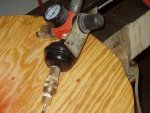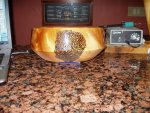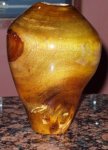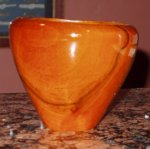Dan Mosley
Member
- Messages
- 1,169
- Location
- Palm Springs, Ca
The last time I bought a can of Laquer was from a online vendor and I purchased Behlan's Gloss Laquer. Currently, I am waiting on my hydraulic hose to arrive so I can complete my spraying system and hook everything up.
In the meantime I thought I would pick up a can of Laquer so I have it when I need it. To my suprise neither HD or Lowes carries Laquer in quarts or gallons. The store paint guy told me that they do not carry it because of the VOC laws in california make it to difficult for retailers to be able to carry it............Did not make alot of sense to me because Sherwinn Williamns and Tru-Tone both carry canned laquer (only one brand at each store) There seems to be very few paint stores that carry canned laquer. The salesman at Tru-Tone told me that even then it has to have a lower VOC in order to carry and sell it in California. Tru-Tone only Carries Mohawk brand but does carry it in satin,semi and gloss and only in gallon cans.
So I thought I would try out the Mohawk brand because it has great reviews and sprays nicely with little thinning............so I read......... Ok so When talking to the guy at Tru-Tone he became anoyed when I said I usually cut it 50/50 with laquer thinner for sealing then when filled to my satisfaction I was cutting it with 1/4 laquer thinner for spraying. So.......crazy me I asked him why he seemed bothered by my method..............He told me I was doing my finishing all wrong.
Ok, I thought...... and im no expert in finishing so ill bite.......So I asked how is it that im doing it wrong? He explained to me that by law I should not be cutting it at all with Laquer Thinner and I should be using Acetone instead and that it is the law...........and he sure was nice enough to point out he carried acetone to............also more expensive than laquer thinner.............what a nice guy............I told him thank you for the advice and ill just take the Laquer for now..........makes you wonder why HD and Lowes sell Laquer thinner in quarts and gallons both hugh?
He also said that all the pros are using a inline Devilbiss filter near there spray guns for added filtration and offered to sell me one at a discount (determined to sell me something else i guess).......At first I was going to pass on it but then thinking I could use it with the degraded regulator from HF until I get my setup going so I asked how much...........$6.00...........yeah ok ill take one.......
See Pic below........I hooked it up to my HF little one and it works well I guess for the price..............
Final Note on the Laquer - If I want higher grade laquer ill have to buy it mail order I guess and even then ill have to find a vendor that will ship to Calif........At some point I want to spray the insturment grade I was reading about but i guess ill have to have it smuggled in. Ohhhhh and for the record - In My Opinion Laquer thinner sprays easier and better than Acetone.
Im sure someone on here can explain the VOC thing better than I just did and I would be interested to know more because it could not be explained very well by anyone I asked other than its illegal.......
In the meantime I thought I would pick up a can of Laquer so I have it when I need it. To my suprise neither HD or Lowes carries Laquer in quarts or gallons. The store paint guy told me that they do not carry it because of the VOC laws in california make it to difficult for retailers to be able to carry it............Did not make alot of sense to me because Sherwinn Williamns and Tru-Tone both carry canned laquer (only one brand at each store) There seems to be very few paint stores that carry canned laquer. The salesman at Tru-Tone told me that even then it has to have a lower VOC in order to carry and sell it in California. Tru-Tone only Carries Mohawk brand but does carry it in satin,semi and gloss and only in gallon cans.
So I thought I would try out the Mohawk brand because it has great reviews and sprays nicely with little thinning............so I read......... Ok so When talking to the guy at Tru-Tone he became anoyed when I said I usually cut it 50/50 with laquer thinner for sealing then when filled to my satisfaction I was cutting it with 1/4 laquer thinner for spraying. So.......crazy me I asked him why he seemed bothered by my method..............He told me I was doing my finishing all wrong.
Ok, I thought...... and im no expert in finishing so ill bite.......So I asked how is it that im doing it wrong? He explained to me that by law I should not be cutting it at all with Laquer Thinner and I should be using Acetone instead and that it is the law...........and he sure was nice enough to point out he carried acetone to............also more expensive than laquer thinner.............what a nice guy............I told him thank you for the advice and ill just take the Laquer for now..........makes you wonder why HD and Lowes sell Laquer thinner in quarts and gallons both hugh?
He also said that all the pros are using a inline Devilbiss filter near there spray guns for added filtration and offered to sell me one at a discount (determined to sell me something else i guess).......At first I was going to pass on it but then thinking I could use it with the degraded regulator from HF until I get my setup going so I asked how much...........$6.00...........yeah ok ill take one.......
See Pic below........I hooked it up to my HF little one and it works well I guess for the price..............
Final Note on the Laquer - If I want higher grade laquer ill have to buy it mail order I guess and even then ill have to find a vendor that will ship to Calif........At some point I want to spray the insturment grade I was reading about but i guess ill have to have it smuggled in. Ohhhhh and for the record - In My Opinion Laquer thinner sprays easier and better than Acetone.
Im sure someone on here can explain the VOC thing better than I just did and I would be interested to know more because it could not be explained very well by anyone I asked other than its illegal.......




















